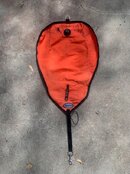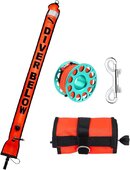Hello
I thought I would post my ideas and suggestions for product improvement here for community participation in the feedback process. I have three suggestions to make - the first two of which I feel will make the product design more user-friendly or simply more usable in an actual emergency. The third is a pain point that caused me a great deal of headache and hours of agony at an airport. I am splitting each feedback/suggestion into a separate post on this thread to keep the length of each post short, and for clarity of focus.
1#) Consider a diver lost at sea for hours and hours and look at the pic below:

Now can a human realistically spend his entire time holding the device up in the air without tiring his arms and shoulders? Dropping it down everytime the pain gets excruciating and lifting it up a few minutes later … can a human persist with it for 48hrs when lost at sea, weak hungry, thirsty, sunburnt, on the verge of passing out? In choppy seas where one has to use the arm occasionally to re-adjust gear or fend oneself momentarily from the impact of waves?
Option 1) It would be good if the base of the LL came with a GoPro style mounting option to attach to an extensible actioncam pole.

This way one could extend the pole 6ft up in the air while comfortably resting one’s forearms and hands on one’s belly while lying on one’s back or with arms supported on the chest when at an almost upright angle. The LL with collapsed pole can be easily attached to one’s BP or stowed in a BCD pocket only to be removed in a M.O.B emergency. Also actioncam users who routinely use a pole can clip the GoPro to a shoulder D-Ring and replace with the LL on the pole … the pole has its own tether which one can slip around the wrists when one needs to use the hand.
Option 2) Design a mini floaty with tether that wraps around the body of the LL - Air inflated by mouth so that it does not affect a divers buoyancy when not in use. Now the diver can just let the LL float around within a meter of him with the uncoiled tether clipped to a shoulder D-Ring. It will rise and fall with the waves and stay afloat transmitting its signal all the while.
Edit: Currently without these solutions, users run the risk of keeping an activated device within 16cm of their body for extended periods of time, which is a health risk advised against - in the manual.

Suggestion #2 in the next post.
Thanks
I thought I would post my ideas and suggestions for product improvement here for community participation in the feedback process. I have three suggestions to make - the first two of which I feel will make the product design more user-friendly or simply more usable in an actual emergency. The third is a pain point that caused me a great deal of headache and hours of agony at an airport. I am splitting each feedback/suggestion into a separate post on this thread to keep the length of each post short, and for clarity of focus.
1#) Consider a diver lost at sea for hours and hours and look at the pic below:
Now can a human realistically spend his entire time holding the device up in the air without tiring his arms and shoulders? Dropping it down everytime the pain gets excruciating and lifting it up a few minutes later … can a human persist with it for 48hrs when lost at sea, weak hungry, thirsty, sunburnt, on the verge of passing out? In choppy seas where one has to use the arm occasionally to re-adjust gear or fend oneself momentarily from the impact of waves?
Option 1) It would be good if the base of the LL came with a GoPro style mounting option to attach to an extensible actioncam pole.
This way one could extend the pole 6ft up in the air while comfortably resting one’s forearms and hands on one’s belly while lying on one’s back or with arms supported on the chest when at an almost upright angle. The LL with collapsed pole can be easily attached to one’s BP or stowed in a BCD pocket only to be removed in a M.O.B emergency. Also actioncam users who routinely use a pole can clip the GoPro to a shoulder D-Ring and replace with the LL on the pole … the pole has its own tether which one can slip around the wrists when one needs to use the hand.
Option 2) Design a mini floaty with tether that wraps around the body of the LL - Air inflated by mouth so that it does not affect a divers buoyancy when not in use. Now the diver can just let the LL float around within a meter of him with the uncoiled tether clipped to a shoulder D-Ring. It will rise and fall with the waves and stay afloat transmitting its signal all the while.
Edit: Currently without these solutions, users run the risk of keeping an activated device within 16cm of their body for extended periods of time, which is a health risk advised against - in the manual.
Suggestion #2 in the next post.
Thanks










